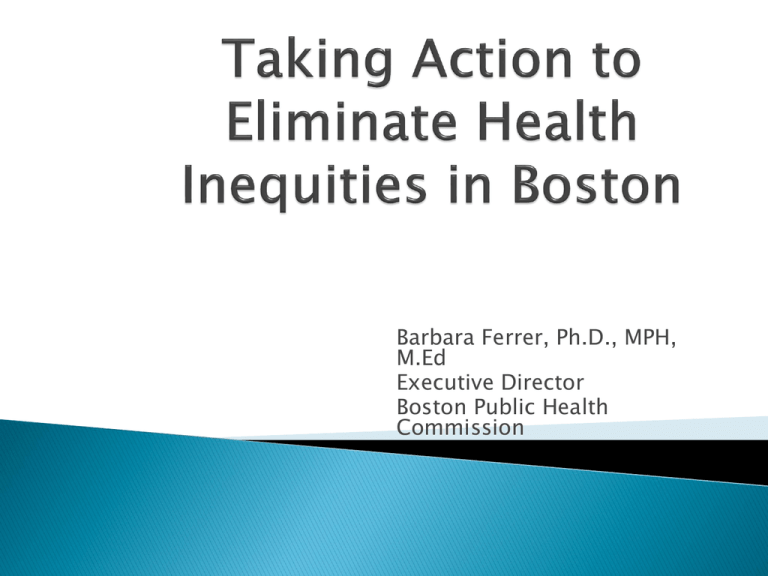Understanding Health Inequities in Boston
advertisement

Barbara Ferrer, Ph.D., MPH, M.Ed Executive Director Boston Public Health Commission Racial Disparities in Boston, 2008 Health Indicator Black Asthma (< 5, hosp) 16.2 per 1000 Birth Weight (Less than 3.3lbs) 3.0% of births Body Weight (Overweight or Obese) 61% Breast Cancer (Morality) 38.2 per 100,000 Death Rate (Mortality) 1,035.2 per 100,000 Diabetes (Mortality) 38.4 per 100,000 Drug Related Mortality 27.0 per 100,000 Heart Disease (Mortality) 200.8 per 100,000 High Blood Pressure 30% HIV/AIDS (Mortality) 12.2 per 100,000 Homicide 31.1 per 100,000 Hospitalization 169.6 per 1,000 Infant Mortality (Mortality) 14.6 per 1,000 Lung Cancer (Mortality) 51.3 per 100,000 Prostate Cancer (Mortality) 72.7 per 100,000 Smoking during pregnancy 3.8% Suicide (Mortality) 5.0 Teen Birth Rate (15 - 17) 18.9 per 1,000 Uninsured 2.7% White 4.1 0.8% 50% 19.8 714.2 11.9 29.9 140.0 24% 3.1 n<5 97.2 3.4 48.3 22.2 4.2% 7.1 12.7 1.0% Infant Deaths per 1,000 Live Births Infant Mortality by Race/Ethnicity, 1996-2008 16.0 12.0 8.0 4.0 0.0 BOSTON Black Latino White DATA SOURCE: Boston resident live births and deaths, Massachusetts Department of Public Health DATA ANALYSIS: Boston Public Health Commission Research and Evaluation Office Life Expectancy in Years Life Expectancy by Race and Ethnicity and Gender, 2003-2008 combined 100.0 78.1 75.0 83.7 80.6 73.5 79.0 50.0 25.0 0.0 DATA SOURCE: Boston Resident Deaths, Massachusetts Department of Public Health DATA ANALYSIS: Boston Public Health Commission Research and Evaluation Office 81.1 74.8 Percent of Low Birth Weight Births Low Birth Weight Births by Maternal Education and Race/Ethnicity, Boston, MA, 2008 16% 14% 12% 10% 8% 6% 4% 2% 0% Black White 13.7% 12.7% 11.6% 9.4% Less than a High School Education 8.8% High School Graduate 7.8% At Least Some College Maternal Education NOTE: These data do not include persons whose race/ethnicity and maternal education were not reported. DATA SOURCE: Boston resident live births, Massachusetts Department of Public Health. DATA ANALYSIS: Boston Public Health Commission Research and Evaluation Office 6 Racial & Ethnic Disparities Infant Mortality & Household Income Per 1,000 Live Births 16.6 11.2 African Americans with Household Income $35,000+ White Americans with Household Income <$10,000 Prevalence of Smoking Smoking Prevalence Among Pregnant Women by Race/Ethnicity, Boston, MA, 2008 5% 4% 4.2% 3.8% 3% 2% 1% 0% Black Smokers White NOTE: These data do not include persons whose race/ethnicity and smoking status were not reported. DATA SOURCE: Boston resident live births, Massachusetts Department of Public Health. DATA ANALYSIS: Boston Public Health Commission Research and Evaluation Office 9 9 Percent of Low Birth Weight Births Low Birth Weight Births by Smoking Status and Race/Ethnicity, Boston, MA, 2008 Black 25% White 23.5% 20% 15% 10% 12.3% 9.8% 7.9% 5% 0% Smokers Non-Smokers NOTE: These data do not include persons whose race/ethnicity and smoking status were not reported. DATA SOURCE: Boston resident live births, Massachusetts Department of Public Health. DATA ANALYSIS: Boston Public Health Commission Research and Evaluation Office 10 10 Racial & Ethnic Disparities Infant Mortality & Prenatal Care Per 1,000 Live Births 12.7 7.1 African Americans White Americans First Trimester Prenatal Care After Prenatal Care 1st Trimester or None DATA SOURCE: Infant Mortality Statistics from the 2003 Period Linked Birth/Infant Death Data Set, National vital statistics reports; vol. 54, no. 16. Hyattsville, MD; National Center for Health Statistics, 2006 Race has no clear biologic or genetic basis…“there are no characteristics, no traits, not even one gene that turns up in all members of one so-called race, yet is absent from others” (L. Adelman. Race and Gene Studies) The meanings of racial designations- White, Black, Asian- are subject to historical, cultural and political forces; “race justified social inequalities as natural”. Racial & Ethnic Disparities Infant Mortality & Nativity, 2003 16 14 Per 1,000 Live Births 12 13.8 10 8 6 9.3 4 2 0 Foreign Born United States Born Black Women DATA SOURCE: Infant Mortality Statistics from the 2003 Period Linked Birth/Infant Death Data Set, National vital statistics reports; vol. 54, no. 16. Hyattsville, MD; National Center for Health Statistics, 2006 WHAT ABOUT RACISM ? Differences in socio-economic status and environmental conditions Differences in exposure to “stress” Differences in access to health care services Differences in diagnostic testing, treatment, and the quality of care received within the health care system Differences in health behaviors Exposure to waste disposal sites Exposure to air pollutants Exposure to “unregulated” job sites (housecleaning, sweat shops, farms) Exposure to sub-standard housing (quality, density, location) Exposure to alcohol and tobacco products and unhealthy foods Exposure to violence Hospitalizations per 1,000 Population Asthma Hospitalizations of Children Under Age 5 by Neighborhood, Boston, 2005-2007 15.2 16.0 12.7 12.0 11.0 9.1 8.8 8.0 7.9 8.4 10.2 10.1 7.9 7.2 5.5 4.0 3.1 3.7 4.3 0.0 *Includes the North End †Includes Chinatown DATA SOURCE: Acute Care Hospital Case Mix files, Massachusetts Division of Health Care Finance and Policy DATA ANALYSIS: Boston Public Health Commission Research Office 4.8 Figure 30.22 Homicides, 2006-2008 Combined NOTE: Data are presented as age-adjusted rates. Neighborhoods are defined by zip codes. DATA SOURCE: Boston resident deaths, Massachusetts Department of Public Health DATA ANALYSIS: Boston Public Health Commission Research and Evaluation Office MAP CREATED BY: Boston Public Health Commission Research and Evaluation Office Figure 30.15b Obese Adult Residents, 2006-2008 Combined NOTE: Body Mass Index (BMI) is calculated from self-reported weight and height. An adult who has a BMI of 30 or higher is considered obese. These data do not include persons of 'Other' or unknown race/ethnicity. Neighborhoods are defined by zip codes. DATA SOURCE: Boston Behavioral Risk Factor Survey, 2006 and 2008, Boston Behavior Surveillance System (BBRFSS), Boston Public Health Commission DATA ANALYSIS: Boston Public Health Commission Research and Evaluation Office MAP CREATED BY: Boston Public Health Commission Research and Evaluation Office Understanding the biologic impacts of social stress (Wadhwa et al. 2001., Culhane et al. 2001., Kramer et al. 2001 ) Theory of allostatic load (Michael Lu. 2002, Rich-Edwards. 2001) “ ..a woman’s chronic exposure to racism creates an allostatic load ..altering the endocrine milieu in which the placenta is established….” (RichEdwards. 2001) Stress Photo: http://www.lam.mus.ca.us/cats/encyclo/smilodon/ Allostasis: Maintain Stability through Change McEwen BS. Protective and damaging effects of stress mediators. N Eng J Med. 1998;338:171-9. Allostastic Load McEwen BS. Protective and damaging effects of stress mediators. N Eng J Med. 1998;338:171-9. Allostatic Load McEwen BS, Lasley EN. The end of stress: As we know it. Washington DC: John Henry Press. 2002 Stressed vs. Stressed Out • Stressed – Increased cardiac output – Increased available glucose – Enhanced immune functions – Growth of neurons in hippocampus & prefrontal cortex • Stressed Out – Hypertension & cardiovascular diseases – Glucose intolerance & insulin resistance – Infection & inflammation – Atrophy & death of neurons in hippocampus & prefrontal cortex Individual behavior exists within a social context Internalized racism can affect health behavior Health behavior alone does not account for unequal burden of disease and death Disparities consistently found across a wide range of disease areas and clinical services Disparities are found even when clinical factors, such as stage of disease presentation, co-morbidities, age, and severity of disease are taken into account Disparities are found across a range of clinical settings, including public and private hospitals, teaching and nonteaching hospitals, etc. Disparities in care are associated with higher mortality among minorities (e.g., Bach et al., 1999; Peterson et al., 1997; Model of Social Determinants of Health Inequities Socioeconomic Status Environmental Exposure Stress Racism Health Behaviors Access To Health Services Access to Testing and Screening Health Outcomes Boston’s efforts to address racial and ethnic inequities in health www.bphc.org/disparities Evidence based foundation: data collection, analysis and dissemination of relevant information Community capacity building and coalition development are the pillars of the work Inequities considered as a central issue and elimination strategies are integrated into core public health functions Working upstream with non-traditional partners is required to address root causes of inequities Funding is directed to support efforts to eliminate inequities Develop institutional competency to engage in sustained efforts to eliminate inequities Support/build community capacity to lead and engage in efforts to eliminate inequities Identify partnership opportunities to enhance and promote efforts to eliminate inequities Providing employee education and training opportunities (core competencies and leadership development) Integrating elimination of inequities in every program (logic models, goals, objectives, activities and evaluation) Identifying and changing internal policies that may perpetuate inequities (ARAC) Reduce low birth weight rates among Boston residents and reduce the gap in low birth weight rates between Black and White Boston residents by 25%. Reduce obesity rates among Boston residents and reduce the gap between White and Black/Latino combined obesity/overweight rates by 30% for children and youth and by 20% for adults. Reduce Chlamydia rates among Boston residents 15 through 24 years of age and reduce the gap in Chlamydia rates between Black, Latino, and White residents 15 through 24 years of age by 25%. Building Community Capacity • $3 million investment to 54 community and health institutions to address health disparities • Key Project Areas: Data Collection, Health Systems, Raising Public Awareness, Workforce Diversity, Patient Education, Violence Prevention and Trauma Response, and Food Access/Obesity Prevention Building Partnerships -- Policy and Advocacy Legislative advocacy and voter education: - Violence Prevention Bill - CORI reform - Re-entry Bill Active engagement with State efforts such as Disparities Council, Governor Patrick administration, and Executive Office of Health and Human Services, and the MA Department of Public Health Board of Health regulatory authority - tobacco control - permitting and inspecting Promote a diverse workforce and leadership team Establish institutional and personal cultural competence Build and sustain diverse partnerships Collect appropriate data to understand the challenge, measure progress and establish accountability Work “upstream” to address root causes of health inequities in health outcomes ◦ Strongly oppose discrimination and racism in all settings ◦ Support affordable, healthy housing ◦ Promote local opportunities for safe exercise and recreational activities ◦ Promote local opportunities for healthy, quality affordable foods ◦ Invest in public education and job training Focus on policies that are good for health, not just health policies Fund efforts promoting community health Build strategic partnerships







